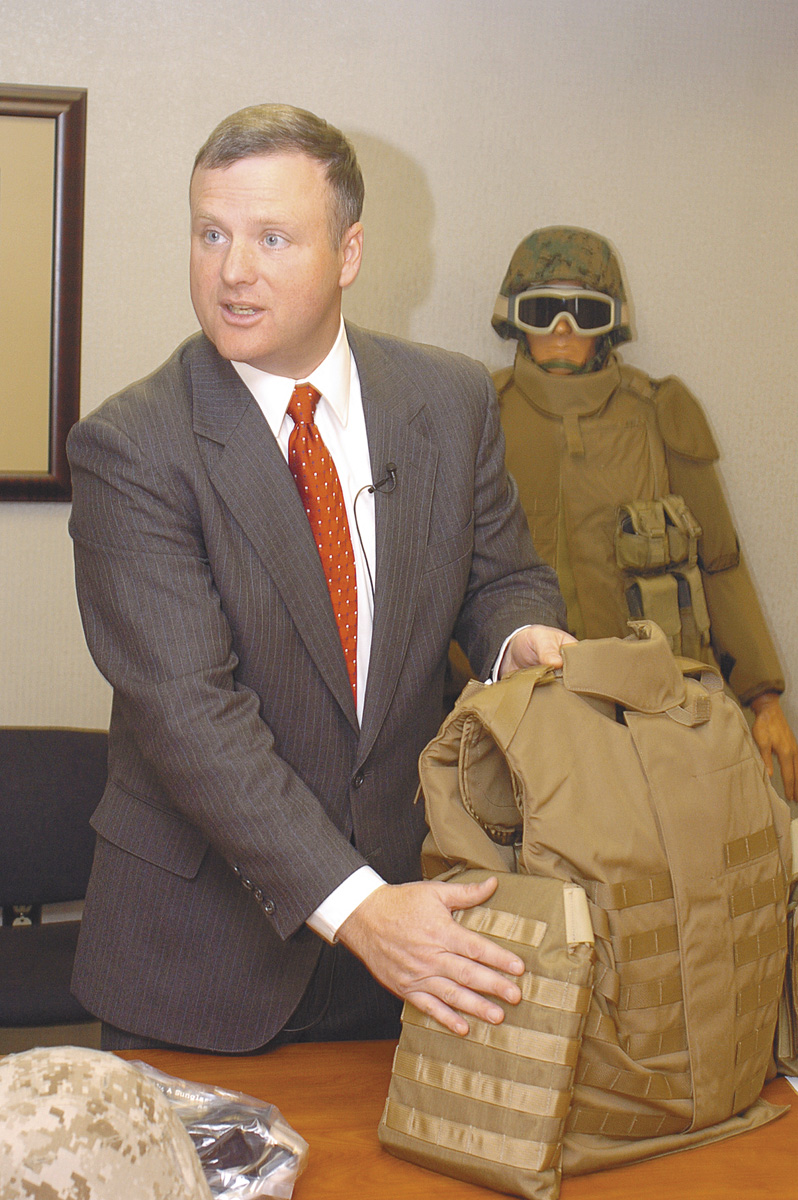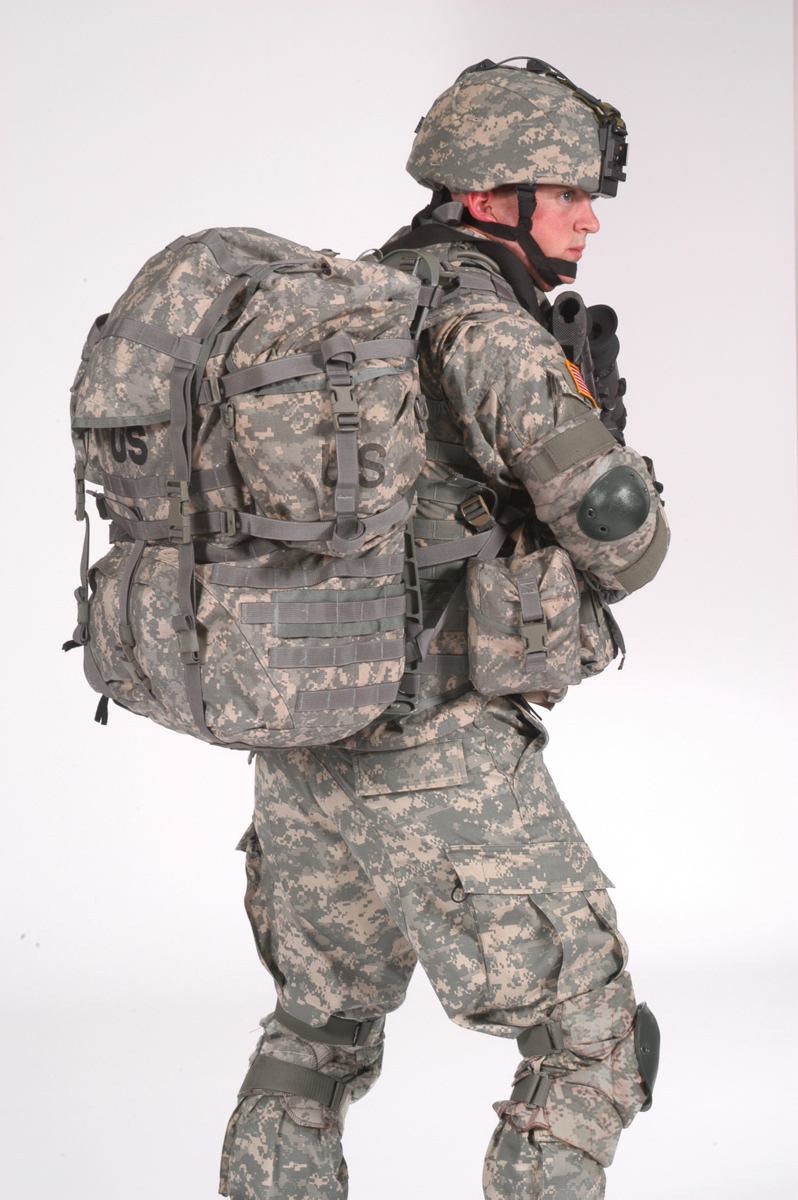|
Combat Integrated Releasable Armor System
CIRAS (Combat Integrated Releasable Armor System) is a modular protective vest designed for US Special Operations Forces by Eagle Industries. The vest is currently the new FSBE II system, and has replaced the FSBE AAVs. It features PALS webbing, making it MOLLE compatible and allowing the attachment of various pouches or accessories. Two versions of the vest are available known as the "Land" and the "Maritime" versions. The vest consists of front and rear panels with pockets for BALCS or SPEAR cut soft armor panels and standard issue SAPI (Small Arms Protective Insert) plates. This gives the wearer up to NIJ Level IV protection on front and back and Level IIIA protection on the sides. On the lower rear side of the front of the vest there are two quick-releasable buckles for attaching groin protection. The wearer's sides are covered by an external cummerbund which is also covered with PALS webbing. The vest body is constructed of 1000 Denier Cordura Nylon and the interior is lined ... [...More Info...] [...Related Items...] OR: [Wikipedia] [Google] [Baidu] |
CIRAS (ISU)
{{disambig ...
CIRAS can mean: * Combat Integrated Releasable Armor System, a modular protective vest designed for US Special Operations Forces * Confidential Incident Reporting & Analysis System, a confidential safety reporting service for transport and infrastructure workers in the United Kingdom and Republic of Ireland * Center for Industrial Research and Service (CIRAS) at Iowa State University Iowa State University of Science and Technology (Iowa State University, Iowa State, or ISU) is a public land-grant research university in Ames, Iowa. Founded in 1858 as the Iowa Agricultural College and Model Farm, Iowa State became one of the n ... [...More Info...] [...Related Items...] OR: [Wikipedia] [Google] [Baidu] |
Full Spectrum Battle Equipment Amphibious Assault Vest
The Amphibious Assault Vest, Quick-Release, or ''FSBE AAV QR'', is a light-weight assault vest system that incorporates both protection and cargo retention. Protection includes soft armor coupled with hard ballistic inserts. Cargo retention capabilities include various pouches and pockets attached via standard PALS webbing. The entire FSBE kit includes the vest body, a throat protector, a groin protector and an assortment of load bearing pouches. A fully loaded vest with armor plates can prove quite heavy, and is typically used only in high-risk direct action (DA) missions. The Combat Integrated Releasable Armor System (CIRAS) suite of equipment manufactured by Eagle Industries is currently the new FSBE II system, and has replaced the FSBE AAVs. Prior to this, the FSBE series replaced the older Close Quarters Battle Equipment Assault Vest (CQBE AV) that had been used by Force Recon since 1996. This kit is available to civilians, with prices for the FSBE vest body starting at US$50 ... [...More Info...] [...Related Items...] OR: [Wikipedia] [Google] [Baidu] |
PALS Webbing
The Pouch Attachment Ladder System or PALS is a grid of webbing invented and patented by United States Army Natick Soldier Research, Development and Engineering Center used to attach smaller equipment onto load-bearing platforms, such as vests and backpacks. It was first used on MOLLE rucksacks, but is now found on a variety of tactical equipment, such as the U.S. Improved Outer Tactical Vest, Interceptor body armor, USMC Improved Load Bearing Equipment backpack and Modular Tactical Vest. It is used to attach items such as holsters, magazine pouches, radio pouches, knife sheathes, and other gear. A wide variety of pouches are commercially available, allowing soldiers to customize their kit. There is also a variety of attachment methods including the Alice Clip, the Natick snap, and soft, interwoven straps. The PALS system has begun to be adopted by other forces, such as the British Army, who use it on their Osprey body armor. PALS consists of webbing sewn onto the load-bearing e ... [...More Info...] [...Related Items...] OR: [Wikipedia] [Google] [Baidu] |
MOLLE (military)
MOLLE (pronounced ,, homophonic with the name Molly) is an acronym for Modular Lightweight Load-carrying Equipment. It is used to define the current generation of load-bearing equipment and backpacks used by a number of NATO armed forces, especially the British Army and the United States Army. The system's modularity is derived from the use of Pouch Attachment Ladder System (PALS) webbing equipment as rows of heavy-duty nylon stitched onto the vest to allow for the attachment of various compatible pouches and accessories. This method of attachment has become a ''de facto'' standard for modular tactical gear, replacing the All-purpose Lightweight Individual Carrying Equipment (ALICE) system used in the earliest modular vest systems (which is still in use with many police forces). Components Tactical assault panel The Tactical Assault Panel (TAP) replaces the fighting load carrier (FLC). It is a bib-like chest rig that can be used alone or mounted on the Improved Outer Tactica ... [...More Info...] [...Related Items...] OR: [Wikipedia] [Google] [Baidu] |
Small Arms Protective Insert
The Small Arms Protective Insert (SAPI) is a ceramic ballistic plate used by the United States Armed Forces. It was first used in the Interceptor Body Armor, a ballistic vest. It is now also used in the Improved Outer Tactical Vest as well as the Modular Tactical Vest, in addition to commercially available "plate carriers". The Kevlar Interceptor vest itself is designed to stop projectiles up to and including 9×19mm Parabellum submachine gun rounds, in addition to fragmentation. To protect against higher-velocity rifle rounds, SAPI plates are needed. ESAPI In May 2005, the U.S. Armed Forces began replacing the standard Small Arms Protective Insert plates with the Enhanced Small Arms Protective Insert (ESAPI). An ESAPI provides protection from .30-06 Springfield M2 armor-piercing (AP) with a steel penetrator in accordance with the NIJ Level IV standard, but costs about $600 per plate, 50% more than SAPI plates. They are produced by Ceradyne, BAE Systems, and ArmorWorks Ente ... [...More Info...] [...Related Items...] OR: [Wikipedia] [Google] [Baidu] |
Khaki
The color khaki (, ) is a light shade of tan with a slight yellowish tinge. Khaki has been used by many armies around the world for uniforms and equipment, particularly in arid or desert regions, where it provides camouflage relative to sandy or dusty terrain. It has been used as a color name in English since 1848 when it was first introduced as a military uniform. In Western fashion, it is a standard color for smart casual dress trousers for civilians, which are also often called ''khakis''. In British English and some other Commonwealth usage, ''khaki'' may also refer to a shade of green known in the US as olive drab. Etymology ''Khaki'' is a loanword from Urdu خاکی 'soil-colored', which in turn comes from Persian خاک ''khâk'' 'soil' + ی (adjectival ending); it came into English via the British Indian Army. Origin Khaki was first worn as a uniform in the Corps of Guides that was raised in December 1846 by Henry Lawrence (1806–1857), agent to the Governor-Gen ... [...More Info...] [...Related Items...] OR: [Wikipedia] [Google] [Baidu] |
Universal Camouflage Pattern
The Universal Camouflage Pattern (UCP) is a digital military camouflage pattern formerly used by the United States Army in their Army Combat Uniform. Technicians at Natick Soldier Systems Center attempted to devise a uniform pattern that would mask the wearer in all seasonal environments.Cramer, Guy, U.S. Army Camouflage Improvement Explained', retrieved 22 October 2022 Laboratory and field tests from 2003 to 2004 showed a pattern named All-Over-Brush (MultiCam Contractor Developed Mod) to provide the best concealment of the patterns tested. All-Over-Brush was selected as the winner over ten other patterns, It was observed at the time that the universal disadvantage of an all-in-one pattern meant compromise and lowered effectiveness in all environments versus a more effective coloration for each environment. Further, the winning All-Over-Brush pattern was not in fact chosen as the final UCP. Instead, U.S. Army leadership utilized pixellated images taken from Canadian CADPAT ... [...More Info...] [...Related Items...] OR: [Wikipedia] [Google] [Baidu] |
SEAL
Seal may refer to any of the following: Common uses * Pinniped, a diverse group of semi-aquatic marine mammals, many of which are commonly called seals, particularly: ** Earless seal, or "true seal" ** Fur seal * Seal (emblem), a device to impress an emblem, used as a means of authentication, on paper, wax, clay or another medium (the impression is also called a seal) * Seal (mechanical), a device which helps prevent leakage, contain pressure, or exclude contamination where two systems join Arts, entertainment and media * ''Seal'' (1991 album), by Seal * ''Seal'' (1994 album), sometimes referred to as ''Seal II'', by Seal * ''Seal IV'', a 2003 album by Seal * ''Seal Online'', a 2003 massively multiplayer online role-playing game Law * Seal (contract law), a legal formality for contracts and other instruments * Seal (East Asia), a stamp used in East Asia as a form of a signature * Record sealing Military * ''Fairey Seal'', a 1930s British carrier-borne torpedo bomber aircra ... [...More Info...] [...Related Items...] OR: [Wikipedia] [Google] [Baidu] |
United States Marine Corps Force Reconnaissance
Force Reconnaissance (FORECON) is one of the United States Marine Corps' special operations capable forces (SOC) which supplies military intelligence to the command element of the Marine Air-Ground Task Force (MAGTF). Force Reconnaissance companies unlike USMC division reconnaissance report to the Marine expeditionary force (MEF) and provide direct action and deep reconnaissance during large-scale operations. The Marine Corps also has Marine Forces Special Operations Command (MARSOC) Raider Battalions that were originally composed of Marine Special Operations Teams formed from Force Recon platoons (Det One) in 2006. MARSOC now has its own separate training pipeline. Force Recon companies continue to operate and focus primarily on direct action, intelligence gathering and maritime raid operations in the visit, board, search, and seizure (VBSS) role. Mission Two different mission types emerged during the Vietnam War, which are still implemented in the Force Reconnaissance mo ... [...More Info...] [...Related Items...] OR: [Wikipedia] [Google] [Baidu] |
Modular Body Armor Vest
The Modular Body Armor Vest (MBAV) is a bullet-proof vest made by Eagle Industries and used by the United States military. The vest is standard issue for many members of the United States special operations forces including the 75th Ranger Regiment. 10,000 vests were deployed on an interim basis with the U.S. Marine Corps while it developed the Scalable Plate Carrier. The vest was also evaluated by the U.S. Army. Design The vest has removable Small Arms Protective Insert plates. The MBAV does not offer as much coverage as the Improved Outer Tactical Vest (IOTV). The vest weighs , averaging about lighter than the IOTV. Lighter armor, which offers greater mobility, has become a priority due to the rugged terrain of Afghanistan. It is only meant to protect the vital areas with armored plates, instead covering non-vital areas with soft armor. History The vest has been standard issue for many members of the American SOF operators including the 75th Ranger Regiment. Those 10,0 ... [...More Info...] [...Related Items...] OR: [Wikipedia] [Google] [Baidu] |



.jpg)

